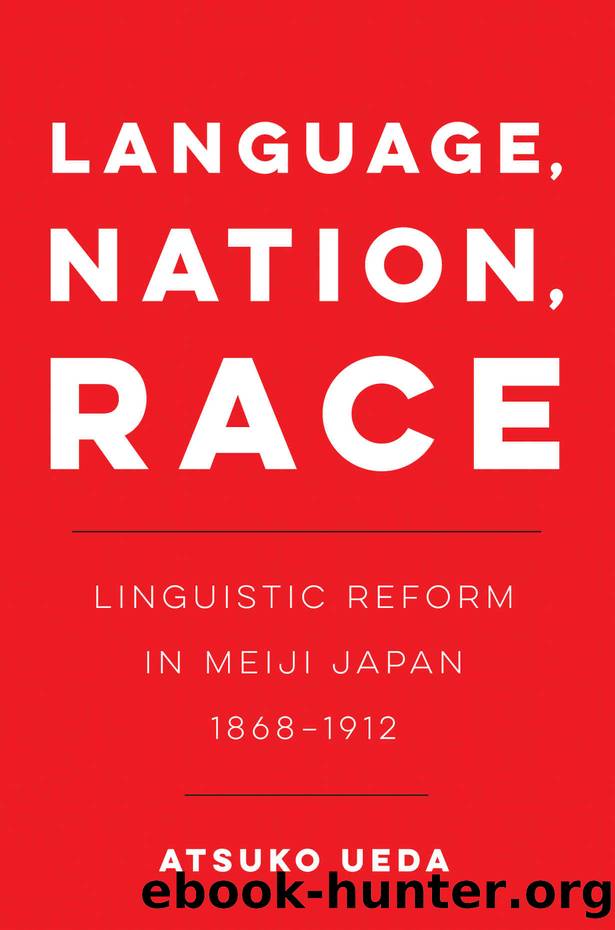Language, Nation, Race: Linguistic Reform in Meiji Japan (1868-1912) by Atsuko Ueda

Author:Atsuko Ueda [Ueda, Atsuko]
Language: eng
Format: epub
ISBN: 9780520381728
Google: 6v4oEAAAQBAJ
Published: 2021-06-01T09:18:16+00:00
CONCLUSION
We have taken multiple steps to examine the intersections between reforms in poetry and fiction by focusing on works of kokubungaku scholars and two leading fiction writers who advocated zokugo in their prose. They intersected at unexpected places, and at the same time differed completely at areas of apparent superficial convergence. Despite the seeming similarity in advocating âtsÅ«jÅ no danwa,â they differed in what they argued against (kanbun for kokubungaku scholars and writing in general for fiction writers). The difference, though in appearance minor, was striking. While kokubungaku scholars sought to identify authentic elegance, the contemporary embodiment of a pure original voice, in the âcurrent language,â fiction writers strove to generate a new language of the present, one severed from the past (a âpastâ represented by Bakin and the practices of communal recitation through which his works were consumed). This difference, I believe, is at the core of Kameiâs statement that genbunâitchi and kokugo reforms had nothing to do with each other.
Yet this difference produced an unexpected overlap, which facilitated a linguistic turn that both sought to achieve, despite lacking any real shared goal or agenda. The severance of the 7â5 metrical rhythm from what they each called zoku was one such example. Kokubungaku scholars embraced the 7â5 metrical rhythm as a âstandard,â the manifestation of the past they sought to recover in the present, while the fiction writers sought to relinquish the past (Bakin-esque prose and communal reading practices) inscribed in the 7â5 metrical rhythm.
In effect, their searches for voices continuous with and discontinuous from the past converge in onchÅ. They shared the conviction that onchÅ was precisely that which defined language and that the past was firmly inscribed in it. To produce continuity with the past, kokubungaku scholars could not relinquish the 7â5 metrical rhythm. In contrast, fiction writersâbe it in the form of BimyÅâs âconversation-styleâ language or that of ShÅyÅâs âelocutionaryâ languageâdesperately sought a new onchÅ that would replace the 7â5 rhythm that defined past practices of reading and writing.
When we deem zoku as a populist choice, it is easy to seamlessly link the efforts of the kokubungaku scholars and fiction writers. However, once we bracket the notion that these writers were in fact in search of a âshared language,â we begin to see the multiple linguistic operations that go into their references to zoku. The aesthetic aspect of language is too often glossed over in a narrative that emphasizes zokuâs populist character. None of the writers denied that they sought an artistic language; in fact no one even questioned it. Without considering zoku as an aesthetic category, we lose sight of the importance that onchÅ played in their arguments.
The typical narrative of kokugo reform says that we must wait until the emergence of Ueda Kazutoshi to completely sever kokugo from kokubun.92 The assumption is that kokubun scholars subjugated kokugo to kokubun; hence any effort to cater to aesthetics is seen as a lingering attachment to the kokubun era. The following chapter will question such a division between kokugo and kokubun.
Download
This site does not store any files on its server. We only index and link to content provided by other sites. Please contact the content providers to delete copyright contents if any and email us, we'll remove relevant links or contents immediately.
Cecilia; Or, Memoirs of an Heiress — Volume 1 by Fanny Burney(32434)
Cecilia; Or, Memoirs of an Heiress — Volume 2 by Fanny Burney(31871)
Cecilia; Or, Memoirs of an Heiress — Volume 3 by Fanny Burney(31854)
The Lost Art of Listening by Michael P. Nichols(7406)
Asking the Right Questions: A Guide to Critical Thinking by M. Neil Browne & Stuart M. Keeley(5633)
We Need to Talk by Celeste Headlee(5542)
On Writing A Memoir of the Craft by Stephen King(4863)
Dialogue by Robert McKee(4321)
Pre-Suasion: A Revolutionary Way to Influence and Persuade by Robert Cialdini(4148)
I Have Something to Say: Mastering the Art of Public Speaking in an Age of Disconnection by John Bowe(3840)
Elements of Style 2017 by Richard De A'Morelli(3307)
The Book of Human Emotions by Tiffany Watt Smith(3238)
Fluent Forever: How to Learn Any Language Fast and Never Forget It by Gabriel Wyner(3028)
Name Book, The: Over 10,000 Names--Their Meanings, Origins, and Spiritual Significance by Astoria Dorothy(2939)
Good Humor, Bad Taste: A Sociology of the Joke by Kuipers Giselinde(2903)
Why I Write by George Orwell(2874)
The Art Of Deception by Kevin Mitnick(2736)
The Grammaring Guide to English Grammar with Exercises by Péter Simon(2710)
Ancient Worlds by Michael Scott(2625)
